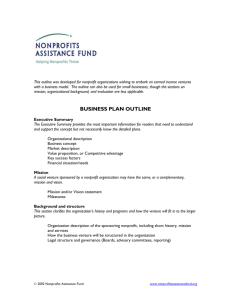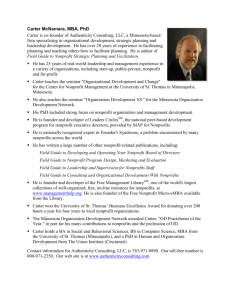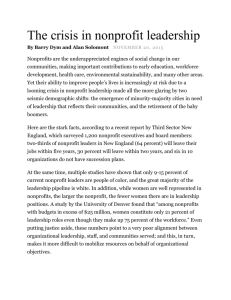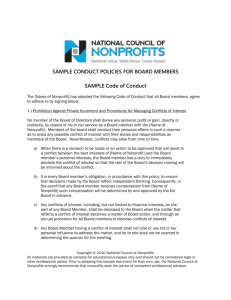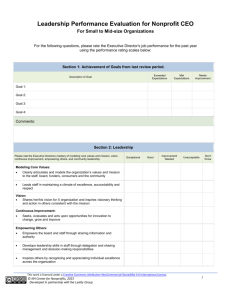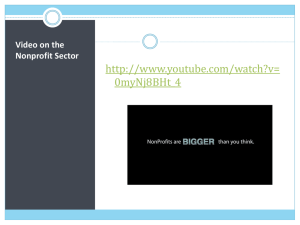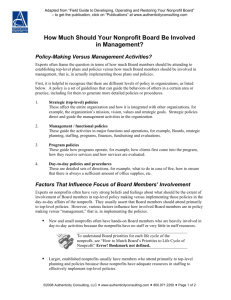PDF layout - Observatori del Tercer Sector
advertisement
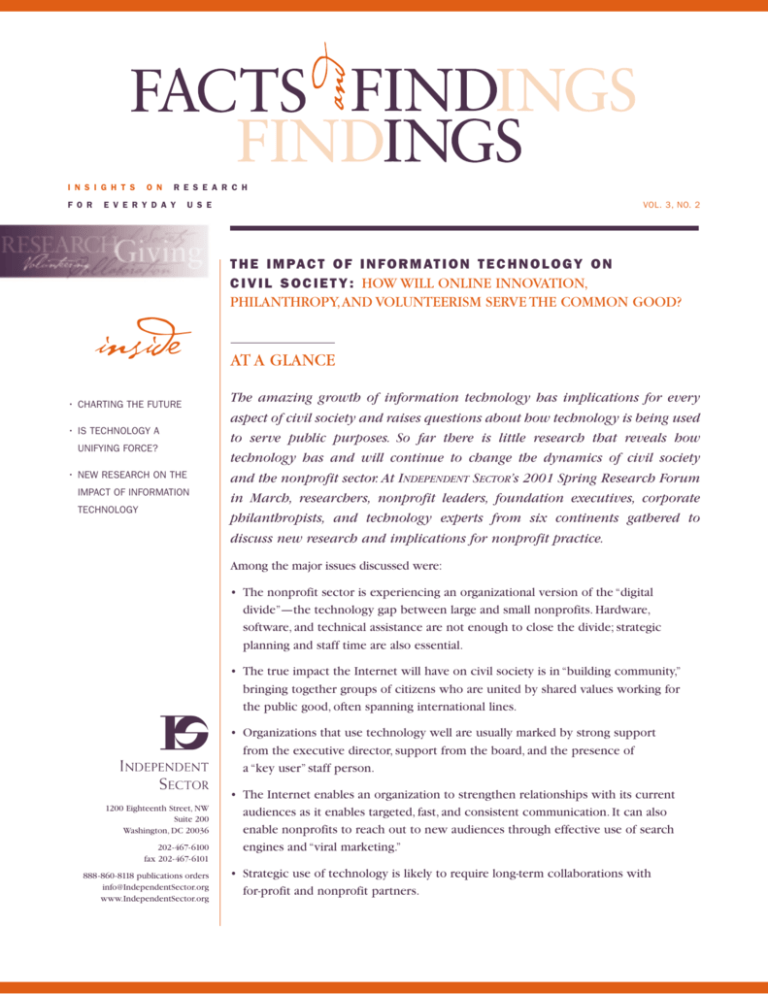
I N S I G H T S F O R O N R E S E A R C H E V E R Y D A Y VOL. 3, NO. 2 U S E T H E I M PA C T O F I N F O R M AT I O N T E C H N O L O G Y O N C I V I L S O C I E T Y : HOW WILL ONLINE INNOVATION, PHILANTHROPY,AND VOLUNTEERISM SERVE THE COMMON GOOD? inside • CHARTING THE FUTURE • IS TECHNOLOGY A UNIFYING FORCE? • NEW RESEARCH ON THE IMPACT OF INFORMATION TECHNOLOGY AT A GLANCE The amazing growth of information technology has implications for every aspect of civil society and raises questions about how technology is being used to serve public purposes. So far there is little research that reveals how technology has and will continue to change the dynamics of civil society and the nonprofit sector. At INDEPENDENT SECTOR’s 2001 Spring Research Forum in March, researchers, nonprofit leaders, foundation executives, corporate philanthropists, and technology experts from six continents gathered to discuss new research and implications for nonprofit practice. Among the major issues discussed were: • The nonprofit sector is experiencing an organizational version of the “digital divide”—the technology gap between large and small nonprofits. Hardware, software, and technical assistance are not enough to close the divide; strategic planning and staff time are also essential. • The true impact the Internet will have on civil society is in “building community,” bringing together groups of citizens who are united by shared values working for the public good, often spanning international lines. • Organizations that use technology well are usually marked by strong support from the executive director, support from the board, and the presence of a “key user” staff person. 1200 Eighteenth Street, NW Suite 200 Washington, DC 20036 202-467-6100 fax 202-467-6101 888 -860-8118 publications orders info@IndependentSector.org www.IndependentSector.org • The Internet enables an organization to strengthen relationships with its current audiences as it enables targeted, fast, and consistent communication. It can also enable nonprofits to reach out to new audiences through effective use of search engines and “viral marketing.” • Strategic use of technology is likely to require long-term collaborations with for-profit and nonprofit partners. T W O CHARTING THE FUTURE OF NEW TECHNOLOGY: IMPLICATIONS FOR CIVIL SOCIETY CONTRIBUTORS: Tae Yoo, director, community development program, Cisco Systems, Inc.; Tae Yoo: The key to success is a well-thought-out strategy, multi-year implementation, and effective partners. Marianne Becton: Technology does not change the basic nature of philanthropy. A SUCCESSFUL TECHNOLOGY PARTNERSHIP INCLUDES: • A well-developed strategy • Multi-year implementation • Identification of key technology partners • Board and executive director support • Involvement of a key “user” of technology Mark Wilson, associate professor, Michigan State University; Trabian Shorters, president, Technology Works for Good; and Marianne Becton, manager, external affairs, Verizon Washington, DC Inc. Many nonprofits and foundations are eager to understand whether emerging technologies and the Internet have a genuine positive impact on civil society and whether nonprofits are seizing opportunities to use technology in innovative ways to fulfill their mission.What are the questions a nonprofit has to ask before entering into a technology partnership with business? According to Tae Yoo, there are three questions Cisco Systems first considers when collaborating with a nonprofit:Who is our customer in philanthropy? What are their missions, their obstacles, and their goals? Who are their customers and constituents? “Only then do we ask the question,‘Can technology have a positive impact on and accelerate these organizations’ ability to fulfill their missions?’” she said. Cisco Systems then works with the organization to develop a well-thought-out strategy with multi-year implementation that identifies key technology partners to achieve significant impact. Using a case study of a successful collaboration,Yoo cited Cisco’s partnership with City Year to integrate technology throughout the organization. She noted that in the first week City Year put its application form online for 17 to 24 year olds to join its volunteering program, it experienced a 250-percent increase in the number of applications received. The organization estimates that using the Internet will save $1 million on training costs over the next five years. Trabian Shorters identified other factors that constitute the successful use of technology in a nonprofit organization.These include strong support from the executive director, support from the board, and the presence of a “key user”—a staff member, who might or might not be responsible for managing technology in an organization, but who is seen as the person to approach with questions. Marianne Becton encouraged nonprofits to develop strategic alliances with companies and foundations so that both can benefit from a long-term relationship. She cautioned, however, that technology should be seen as a productivity-enhancing tool that “does not change the nature of philanthropy.”Technology should enhance a charity’s fundraising by automating routine tasks, leaving staff more time to build relationships with donors and beneficiaries. T H R E E William Galston: The Internet can encourage more intense, narrowly focused communities. Vinay Bhagat: “Viral marketing” is the power of word-of-mouth marketing taken online. CREATING VIBRANT SPACES FOR CIVIL SOCIETY ORGANIZATIONS ON THE INTERNET AFTER E-COMMERCE CONTRIBUTORS: William Galston, professor and director, Institute for Philosophy and Public Policy, University of Maryland; Larry Kirkman, president, Benton Foundation; Vinay Bhagat, CEO, Convio; Edward Lang, vice president, strategic partnerships and technology, CVENT; and Howard Tuckman, dean, Faculty of Management, Management Education Center, Rutgers University As e-commerce and commercialism of the Internet expands, vibrant spaces for civil society organizations may become more difficult to develop and make visible on the Internet, according to William Galston. Researchers noted that technology has the capacity to bring volunteers and advocates together from all over the world around a common cause.While the Internet can encourage discussion and advocacy through “online” communities, there is a danger that these communities can create sealed-off, isolated groups that narrow democratic deliberation. Galston warned that the kinds of voluntary communities sparked by the Internet “have a tendency to organize around a narrow range of interests,” rather than a concern NEW TERMS Viral Marketing—Internet-based word-of-mouth marketing. Some websites are now encouraging loyal donors and advocates to tell like-minded friends by entering their email addresses and sending a personalized message. These people, in turn, tell more friends, and, like a virus, the message reaches a large number of new potential donors or advocates quickly and inexpensively. An example is Planned Parenthood’s recent President’s Day campaign, which raised more than $500,000 online, with 90 percent of the contributions coming from people who had never donated before. for the common good. “Homogeneous communities tend to intensify agreement within the community around more and more extreme forms of the agreement that brought the members together in the first place,” he said. Galston said it is a mistake “to believe that if we have empowered groups to speak, we have done everything that is necessary in order to build a vibrant civil space for democracy.” ASP—A new way to use and pay He said the Internet’s for software. These so-called architecture is egalitarian, “Application Service Providers” but not necessarily offer donor database, website democratic since it is content management, and other sophisticated software systems often dominated by for a monthly fee. The software corporate sites. To and data reside on the ASP’s encourage greater levels computers, and the organization of citizen engagement accesses it through a secure Internet connection. An example in democracy, Galston is United Jewish Community’s advocates the development FedWeb, which offers UJC’s of “dot-civ” Internet domains local federations the ability to easily accept online donations, that would facilitate the register volunteers, and host discussion and advocacy discussions. of citizens around societal issues. Larry Kirkman said that the Internet has created “an appetite for trusted information intermediaries” and that nonprofits can help fill that role by providing intermediary websites that aggregate nonprofit knowledge. With commercial search engines only covering about 20 percent of the Internet he believes that “nonprofits must think of themselves as information sources in a new way.” F O U R BUILDING COMMUNITIES: IS TECHNOLOGY A UNIFYING FORCE? CONTRIBUTORS: David Eisner, vice president, corporate relations, AOL Time Warner, and senior vice president, AOL Time Warner Foundation; Mike Whitlam, chief executive, Mentor Foundation; James Austin, professor, Initiative on Social Enterprise, Harvard Business School; and Simon Rogers, deputy editor, Guardian Unlimited Technology can be used to mobilize people globally around a common cause to achieve world-changing results far beyond the promise of enabling nonprofit organizations to perform important functions, such as fundraising and recruiting volunteers more effectively. In contrast to some of the concerns expressed by William Galston, David Eisner asserted that “the truly transformative impact that the Internet will have on nonprofits is specifically in the area of building community.” James Austin said that technology is redefining “community” since it is no longer focused on geography but on other commonalities that can join people across cyberspace. He suggested a new definition of community:“a group of people bound together by shared activities, purpose, and values.” According to Eisner, four trends are critical to understanding the power of the Internet in building communities: • More people will find it easier to form more affiliations as a result of the Internet. • Asking individuals to give will get easier, because information and action can now be integrated. For example, donors could read about the earthquake in India and then give and volunteer at the same time using the Internet. • News, fundraising, online communities, and ways to help, which Eisner termed the “cycle of engagement,” will become frictionless, since the Internet enables people to learn about a problem and take action immediately and seamlessly. • Through networking, people will be able to work together more closely in high-quality information sharing and learning communities. James Austin: Community is no longer focused just on geography. David Eisner: The truly transformative power of the Internet is in building community. Online interaction offers a powerful organizational tool for advocacy campaigns. “As a communications tool, as a campaigning tool, it’s incredible,” said Mike Whitlam. But this powerful connection cannot become reality unless nonprofit organizations have the capacity to use technology. “What’s really important is even where grants are not related to technology, grantmakers need to take an interest in their grantees’ technological proficiency in the same way that they take an interest in their staff capability, their management, and their financial credibility,” Eisner said. Turning to current trends in e-philanthropy, Austin asserted that, just like the Internet business world, the e-philanthropy community—both for-profit and nonprofit—is suffering labor pains.“There will be more closures and consolidation, but the space will not go away,”Austin said.“Internet technology has irreversibly changed the philanthropic capital market.” Austin identified four forces as the critical shapers of the new technology-based e-philanthropy community: • • • • economic pressures mistrust clashing cultures technology readiness “The potential is enormous,” he concluded.“But its realization will depend fundamentally on the willingness and the ability of nonprofits and e-philanthropy enterprises to forge new and mutually beneficial relationships rooted in shared mission and purpose.” F I V E Elizabeth Ramrayka: Does the Internet trade intimacy for efficiency? Nearly 300 researchers, practitioners, and others from six continents gathered at the INDEPENDENT SECTOR Spring Research Forum, March 15-16, 2001, in Washington, DC, to discuss the impact of the Internet on civil society. Nick Allen: The Internet offers opportunities for national-local collaboration. AT THE SPEED OF LIGHT: ONLINE PHILANTHROPY AND RESOURCES SERVING THE COMMON GOOD CONTRIBUTORS: Randi Shade, co-founder, Charitygift; Nick Allen, president, Donordigital; Jay Backstrand, CEO, ImpactOnline; Putnam Barber, president, Evergreen State Society; and Elizabeth Ramrayka, editor, Voluntary Sector The Internet offers important resources that serve nonprofits, but experts warned that organizations must take a strategic, collaborative approach during these volatile, fast-moving times. Jay Backstrand remarked that consolidation is leading to collaboration that will be good for the nonprofit sector. According to Nick Allen, large national nonprofits such as United Jewish Communities and Girl Scouts of the USA are investing in tools to enable their local partners to easily build effective websites. These sites offer consistent branding, advocacy resources, and the ability to attract contributions and volunteers. What the e-business community is now experiencing is that the rules of successfully running a business are the same as they’ve ever been, according to Randi Shade. She described her experience in launching Charitygift, a for-profit company to enable people to give contributions to charity as gifts. She initially received venture capital funds, and then her company was bought by another dot-com, CharitableWay. However, the company could not grow the business fast enough to provide the return the investors demanded, and the company shut down. Shade noted that the fundamental tools for running a sustainable business go far beyond a good idea and the latest technology. Having a market and long-term adequate investment are more important keys to success, she concluded. S I X FOR MORE INFORMATION The Impact of Information Technology on Civil Society: How Will Online Innovation, Philanthropy, and Volunteerism Serve the Common Good? Working Papers NEW RESEARCH ON THE IMPACT OF INFORMATION TECHNOLOGY Forty-six researchers from the United States, China, Korea, the Philippines, the United Kingdom, Brazil, Israel, Mexico, and other countries reported new research on how information technology has helped nonprofits and civil society. For example: • Junki Kim of Seoul National University reported that a coalition of 900 Korean civil society organizations used electronic advocacy as part of an unprecedented campaign to target 86 corrupt politicians for defeat in 2000; they defeated 59. Laxmi Ramasubramanian of the University of New England presented her paper, Where’s the Power in Empowerment? How Community-Based Organizations Shape Social Policy. • Michele Waslin of the University of Notre Dame described the way human rights organizations in Mexico have used the Internet to publicize their concerns. • Stephanie Creaturo of NPower NY discussed how some nonprofits have successfully used IT training programs to improve the job skills of low-income workers. • Linda Nemec and Brian Kroneman of the Citizens Democracy Corps reported that the Internet has made it possible for more full-time business people to use their expertise to help counterparts in developing countries learn how to survive in a market-based and increasingly competitive world economy. But researchers also found major problems involving technology and nonprofits.The first is the organizational version of the “digital divide”—the technology gap between large and small nonprofits. Jo Anne Schneider of Indiana University of Pennsylvania, reporting on several small, minority-based nonprofits in Kenosha,Wisconsin, noted that “simply providing technology and technical assistance to small, community-based organizations is insufficient to close the digital divide.The most essential issue for these organizations is staff time—and using information technology adds an additional drain to already overcommitted staff.” Finally, Maria Papadakis of Virginia Polytechnic Institute and State University said, “One issue that is often neglected in technology projects and programs is the opportunity cost of these funds. In other words, what projects and programs are being given up for technology, and might these alternatives achieve the same results (or better) for less money?” A collection of 28 working papers from researchers and practitioners studying technology and its effects on civil society. Download individual papers FREE at www.IndependentSector.org. Or order the full volume: 479 pages, $50 ($35 for INDEPENDENT SECTOR members) plus shipping and handling. 888-860-8118. Also available: Full coverage of the plenary session remarks at www.IndependentSector.org. This publication is made possible through support of the INDEPENDENT SECTOR Research Program by the Ford Foundation, the Lilly Endowment, Inc., and other donors. IS would also like to recognize the sponsors of the 2001 Spring Research Forum: Blackbaud, Inc., Convio, Fidelity Investments Charitable Gift Fund, KindMark, Verizon Foundation, and Westat. INDEPENDENT SECTOR RESEARCH PROGRAM INDEPENDENT SECTOR is a nonprofit, nonpartisan coalition of more than 700 national nonprofit organizations, foundations, and corporate philanthropy programs, collectively representing tens of thousands of charitable groups in every state across the nation. Its mission is to promote, strengthen, and advance the nonprofit and philanthropic community to foster private initiative for the public good. INDEPENDENT SECTOR’s Research Program works to build the research necessary to accurately define, chart, and understand the nonprofit sector and ways it can be of greatest service to society. Signature projects include the Nonprofit Almanac, Giving and Volunteering in the United States, and the Measures Project. © INDEPENDENT SECTOR, ISSN #1526-8381 www.IndependentSector.org SUMMER 2001
